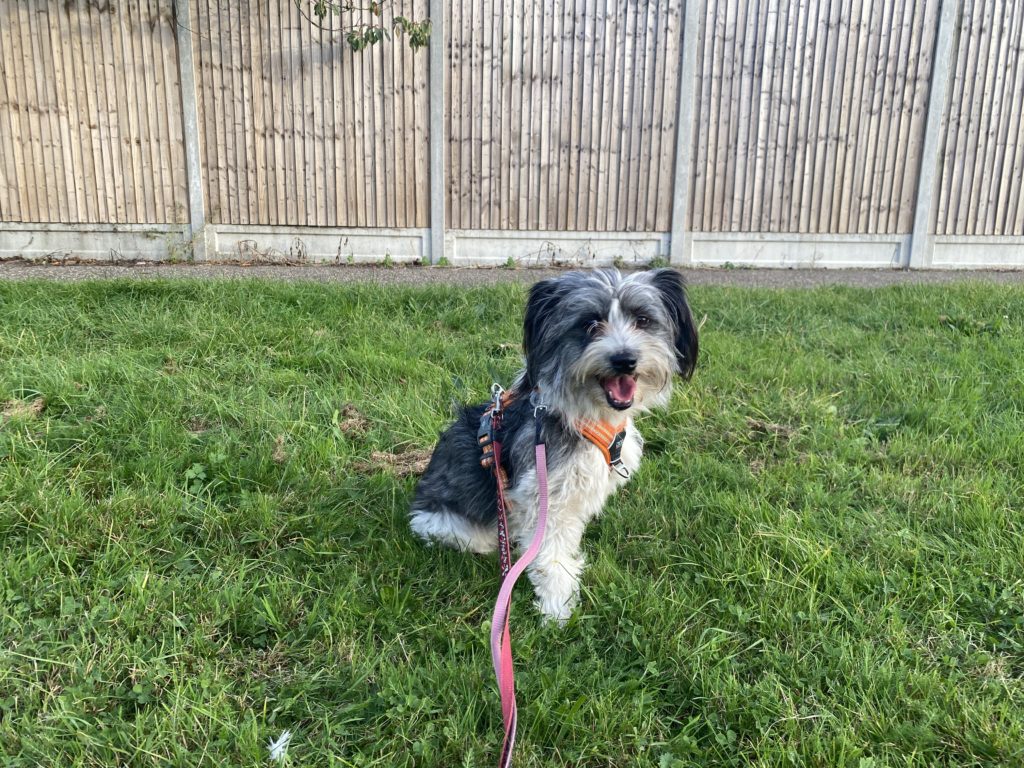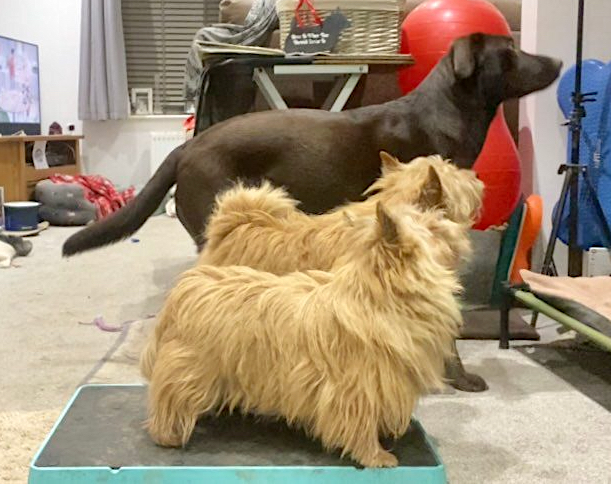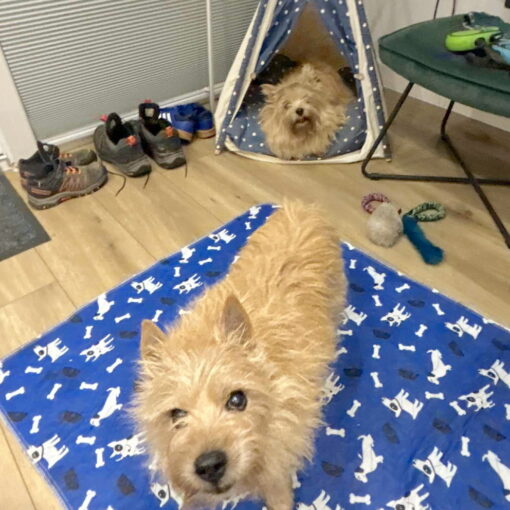Sitting on cue is one of the first things most people want to teach their dog; it’s handy for focus, can be part of the method to stop jumping up at people and is considered good manners for a puppy or adult dog to sit before a meal, crossing the road or having their lead put on. A sit is also used to help teach new exercises to dogs including in Obedience, Heelwork to Music and even within Canine Conditioning, making it a highly useful position to teach our dogs!

However it can put a fair amount of stress into the rear leg joints especially if practised lots every day.
Consider how often the average pet dog may be asked to sit in a day; sit to go outside, sit before breakfast, sit to put lead on, sit to go out for a walk, sit to cross over several times, sit to have lead taken off … then add in the training practise of the sit, using sit for stays, formal recall, during Heelwork etc. It soon adds up!
To sit there is movement in the hips, knees, ankles, toes and even back up to the lower spine. There is also movement to the shoulders, top and mid spine although a lot less pressure up there. There is a lot happening with the joints as well as the muscles, ligaments and tendons – more than it looks like when we see our dog sit!
When teaching a puppy to sit it can be easy to focus on this exercise over others, and so a puppy in training may be repeating the sit several times in a session. All that joint movement, but have we prepared the body for that movement? Has our puppy just woke up full of energy and we want to help them not jump up and hurt themselves? A moment longer of just walking around the room or garden can help the body ‘warm up’. Have we ensured our puppy isn’t doing all of these repetitive sits on flooring that they are sliding on? When dogs cannot gain effective grip so their feet and legs are sliding out from under them it can look very cute, but this also causes dogs to need to work harder to try and no slip which can cause micro tears and pulls on tendons and ligaments – something we cannot see happen but over weeks, months or years can lead to actual injury that may require surgery or professional therapy to help rectify. Just adding a non slip rug or yoga mat can make such a difference!
As dogs go through their growth developments we can see times when they appear to forget how to sit when asked, or act as if they haven’t heard us asking for it. This can happen with any dog while they are going through puppyhood or adolescence and larger breeds can be more susceptible to having moments where the sit just doesn’t happen! Many breeds of dogs can experience a form of ‘growing pains’ where they literally can have a nap and wake up noticeably taller which shows how much work the joints are already doing. Some dogs have growth spurts all over, some shoot up at one end before the other but all this movement can make something like a simple sit very uncomfortable to try.
If a dog has an exiting joint issue or arthritis then something as everyday as a sit can be difficult or even painful. Although arthritis and joint issues can affect dogs at any age, the older a dog becomes the more likely they are going to experience stiffness, discomfort while sitting or even difficulty standing back up again! Did you know at least 20% of ALL dogs have been diagnosed with osteoarthritis- that’s 20%+ of dogs aged a few months to 18+ years and there will be many more undiagnosed. That number rises to 80% of dogs over the age of 8 years have osteoarthritis. Imagine how many dogs are trying to sit on cue with the discomfort of arthritis happening!
It’s no wonder that Senior dogs can either refuse to sit more and more or look uncomfortable sitting and then moving back out of it. One area that can decline in older dogs are the muscles in the rear end which is to be expected as typically dogs have 60-70% of their body weight carried in their front end and only 30-40% in the rear end and gradually dogs can use the front more and more as the rear becomes uncomfortable; once the muscles begin declining dogs will learn to adjust their movements such as rolling forward to use the front legs to pull themselves up or try several smaller movements to prepare for the standing action and the saying ‘move it or loose it’ applies here as when dogs stop using the rear end to push themselves into a stand but instead pull themselves with the front the rear muscles are used less and start to decline to the point that the muscle strength disappears making a simple sit incredibly difficult and sometimes impossible.

Senior dogs can often start to find the sit difficult to do so this would be my initial point to check if I found my dog was not sitting on cue when they previously always have done. It might be that they have just woke up so need to warm up a little, the floor may provide no grip so they loose confidence when asked to sit or they are aware that they don’t have the strength or balance to sit comfortably and so avoid the position. If you spot your senior dog – or any age dog – is reluctant to sit or struggles to stand back up over a period of days or weeks but has previously always sit without issue it can be worth a trip to the vets to check for discomfort and potentially avoid a minor issue becoming something big!!
For training – sometimes a Sit is the most useful option. During conditioning and strengthening exercises the sit is used a fair amount when dogs are able to sit. We also use a lot more standing exercises than sitting. We can consider using other positions within our training practise such as when we teach a formal recall we could leave our dogs in a down or stand position instead of a sit. If working on our dog staying still we could look at unusual positions they are comfortable doing such as standing, putting front paws on a low item or doing a play bow! Sit is useful and in many type of training including for safety the sit can be essential for many owners, but we have many alternatives we can alternate with too.
When I’m teaching Heelwork, for example, I encourage owners to focus on the Heelwork and not be too worried about asking for a sit at the end every time – unless they are still teaching the sit or they are heading into competitive obedience. Reward the heel while in motion and maybe add a sit here and there to have some practise but not overusing it! When we practise the foundation positions of sit, down and stand we can add in watch me, nose touch and twists and spins to give more variety so sit is one in 6 rather than one in 3 options plus it’s more interesting for our dogs!!

Many show dogs breeze through life without having a default sit and in fact my own Norwich Terrier Merlin hardly did any sits when younger. He had a sold stand from very young for his showing and passed his Kennel Club Bronze and Silver Good Citizen awards using a Stand Stay (Gold level we used down). I only taught him a formal sit when he 2 years old and I realised he had his first obedience competition in 3 weeks and didn’t have a sit on cue, so we taught it! At the level he was at (prebeginners) he needed to sit at the start and finish of heel on lead, start and finish of heel off lead, used at the start, middle and end of formal recall and for one of the two stays so quite important for that type of dog sport! Yet Merlin could do Stays, Target Training, Retrieves, Heelwork and activities like Tricks, Heelwork to Music, Treibball, Parkour, Hoopers and Agility without ever needing to sit! Even now at nearly 12 years old he can sit when asked but typically we prefer stand or playbow when we need a pause!! That playbow is his favourite for Emergency Stops, Stay, posing for the camera …!

So in summary, Sit in itself isn’t a negative thing to teach our dogs, but it can benefit our dogs to look at additional factors such as flooring, warming up, number of repetitions and how comfortable our dogs are when doing the sit and use it as one of many ways to assess our dogs’ overall comfort and abilities.
Thankyou for reading. I’m a Certified Professional Canine Fitness Trainer (since 2014), have passed the Canine Arthritis Management Level 1 course and work with dogs of all ages with a special passion for our Super Seniors!
Check out Canine Arthritis Management resources: C.A.M.

To see more of our activities and events including online join our mailing list: Register Here
To receive our monthly newsletter, The Dogs’ Frolics, with top tips, dog achievements and more of our blogs you may have missed here is the sign up: The Dogs’ Frolics Newsletter


